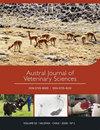益生元治疗家兔肠道球虫病现场病例中大肠杆菌和沙门氏菌的流行及抗菌敏感性分析
IF 0.5
4区 农林科学
Q3 VETERINARY SCIENCES
引用次数: 0
摘要
. 球虫感染可促进肠杆菌科肠道细菌的增殖。该家族成员在家兔中的细菌感染可对其健康产生负面影响,并导致高死亡率,特别是在年轻个体中。本研究旨在探讨益生元处理对家兔天然肠道球虫病中大肠杆菌和沙门氏菌的影响。从埃及Beni-Suef的一个养兔场挑选了45只兔子。45只兔中无球虫15只作为阴性对照组(NC组),自然感染球虫30只。将感染家兔随机分为阳性对照组(PC)和益生元治疗组(PT),后者连续8 d口服益生元。在治疗过程中每天评估粪卵囊计数。治疗后8 d,每组5只兔安乐死,进行肠道微生物学检查。治疗后第8天,PT组卵囊计数显著(P≤0.05)降低(5.33 ×10 3±0.89),大肠杆菌和沙门氏菌感染率显著(P≤0.05)降低(分别为66.7%和26.4%)。PC组卵囊计数显著增高(21.67×10 3±0.82 OPG),大肠杆菌和沙门氏菌感染率显著增高(分别为86.7%和46.7%)。NC组仍然没有球虫,只有大肠杆菌,没有沙门氏菌感染。体外药敏试验结果表明,大肠杆菌对大部分抗微生物药物均具有高度耐药性,而沙门氏菌的耐药性变化较大。综上所述,益生元治疗显著降低了大肠杆菌和沙门氏菌感染与肠道球虫病共存的自然感染家兔的患病率。本文章由计算机程序翻译,如有差异,请以英文原文为准。
Prevalence and antimicrobial sensitivity of Escherichia coli and Salmonella species in field cases of rabbit intestinal coccidiosis treated with prebiotic
. Coccidian infection may promote the proliferation of gut bacteria of the family Enterobacteriaceae. Bacterial infections by members of this family in rabbits can induce a negative impact on their health and lead to high mortality, especially in young individuals. This study aimed to investigate the effect of prebiotic treatment on Escherichia coli and Salmonella species during natural intestinal coccidiosis in rabbits. Forty-five rabbits were selected from a rabbit farm in Beni-Suef, Egypt. Out of the 45 rabbits, 15 were coccidia-free and used as the negative control group (NC group) and 30 were naturally infected with coccidia. The infected rabbits were randomly divided into two equal groups, the positive control group (PC) and the prebiotic treated group (PT) which was orally treated with prebiotic for 8 successive days. Faecal oocyst count was assessed daily during the course of treatment. At 8 days post-treatment, 5 rabbits from each group were euthanised for the microbiological examination of the intestinal tract. On day 8 post-treatment, the PT group showed a significant ( P ≤0.05) reduction in the oocyst count (5.33 ×10 3 ± 0.89) with a significant ( P ≤0.05) decline in the prevalence of E. coli and Salmonella (66.7 % and 26.4%, respectively). The PC group showed highly a significant oocyst count (21.67×10 3 ± 0.82 OPG), with a significant increase in the prevalence of E. coli and Salmonella (86.7 % and 46.7 %, respectively). The NC group remained coccidian free and exhibited only E. coli with no Salmonella infection. The in vitro susceptibility test showed that E. coli isolates were highly resistant to most of the tested antimicrobials while Salmonella isolates showed variable resistance profiles. In conclusion, the prebiotic treatment significantly reduced the prevalence of E. coli and Salmonella infections coexisted with intestinal coccidiosis naturally infected rabbits.
求助全文
通过发布文献求助,成功后即可免费获取论文全文。
去求助
来源期刊

Austral Journal of Veterinary Sciences
Veterinary-General Veterinary
CiteScore
1.60
自引率
0.00%
发文量
18
期刊介绍:
Austral Journal of Veterinary Sciences (formerly Archivos de Medicina Veterinaria) publishes original scientific contributions in English, containing the latest developments and discoveries in veterinary sciences. The journal covers topics such as animal health and production, preventive medicine, zoonosis, pharmacology and therapeutics, methods of diagnosis, and other areas related to the veterinary field.
Austral Journal of Veterinary Sciences aims to divulge information about advances in veterinary medicine among universities, research centres, industries, government agencies, biologists, agronomists and veterinarians.
 求助内容:
求助内容: 应助结果提醒方式:
应助结果提醒方式:


